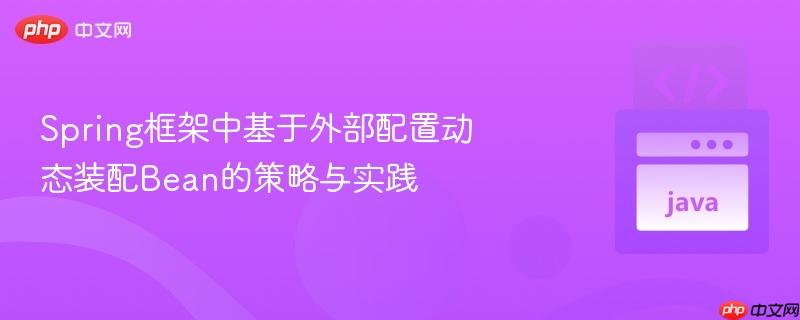
本文探讨了在Spring应用中根据外部配置动态装配Bean的两种主要策略。首先介绍如何使用`@Qualifier`注解进行静态、编译时确定的Bean依赖注入,适用于配置项相对固定的场景。随后,深入解析`BeanFactoryPostProcessor`的强大能力,展示其如何在运行时解析外部配置(如YAML),并程序化地注册Bean定义,从而实现高度灵活的动态Bean管理。
在构建复杂的企业级应用时,我们经常需要根据外部配置文件来决定应用程序的运行时行为。例如,一个Pipe(管道)组件可能需要从不同的DBReader(数据库读取器)中获取数据,并通过一系列DataProcessor(数据处理器)进行处理。DBReader的具体实现(如JdbcReader、FileReader)及其参数,以及DataProcessor的列表和各自参数,都可能由外部配置(如YAML或属性文件)动态指定。
// 核心业务组件:管道
class Pipe {
DBReader reader;
List<DataProcessor> dataProcessors;
public Pipe(DBReader reader, List<DataProcessor> dataProcessors) {
this.reader = reader;
this.dataProcessors = dataProcessors;
}
// ... 其他方法
}
// 数据读取接口及其实现
interface DBReader {
Data readData();
}
class JdbcReader implements DBReader {
private DataSource dataSource; // 依赖于数据源
public JdbcReader(DataSource dataSource) {
this.dataSource = dataSource;
}
// ... readData() 实现
}
class FileReader implements DBReader {
private String fileName; // 依赖于文件名
public FileReader(String fileName) {
this.fileName = fileName;
}
// ... readData() 实现
}
// 数据处理接口及其实现
interface DataProcessor {
void processData(Data data);
}
class CopyDataProcessor implements DataProcessor {
private int param1;
private int param2;
public CopyDataProcessor(int param1, int param2) {
this.param1 = param1;
this.param2 = param2;
}
// ... processData() 实现
}
class DevNullDataProcessor implements DataProcessor {
private String hostName;
public DevNullDataProcessor(String hostName) {
this.hostName = hostName;
}
// ... processData() 实现
}外部配置可能如下所示,其中通过id和Ref(引用)来关联不同的组件:
datasources:
dataSource1:
connectionString: "postgres://la-la-la"
dataSource2:
connectionString: "mysql://la-la-la"
dbReaders:
reader1:
type: jdbc
dataSourceRef: dataSource1
reader2:
type: file
filename: "customers.json"
dataProcessors:
processor1:
impl: com.example.processors.CopyDataProcessor
param1: 4
param2: 8
processor2:
impl: com.example.processors.DevNullProcessor
hostName: Alpha
pipes:
pipeA:
readerRef: reader1
dataProcessorsRef: [processor1, processor2]
pipeB:
readerRef: reader2
dataProcessorsRef: [processor2]这种场景的核心挑战在于,Spring如何根据这些外部配置中的refId来自动装配相应的Bean,尤其是在Bean的类型和数量可能在运行时动态变化的情况下。
当Bean的定义相对固定,并且在Java代码中可以预先确定时,@Qualifier注解是解决同类型Bean之间歧义性装配的有效手段。它允许我们为Bean指定一个唯一的标识符,并在注入时精确引用。
首先,我们需要在Spring的配置类中定义各个组件的Bean,并使用@Qualifier为它们指定一个名称。这些名称通常与外部配置中的id或Ref对应,但此时它们是硬编码在Java代码中的。
import org.springframework.beans.factory.annotation.Qualifier;
import org.springframework.context.annotation.Bean;
import org.springframework.context.annotation.Configuration;
@Configuration
public class StaticBeanConfig {
// 假设 DataSource 已通过其他方式(如 application.properties 或 @Bean)定义并可用
@Bean
public DataSource postgresDataSource() {
// 实际中这里会配置PostgreSQL数据源
return new MockDataSource("jdbc:postgres://la-la-la");
}
@Bean
public DataSource mysqlDataSource() {
// 实际中这里会配置MySQL数据源
return new MockDataSource("jdbc:mysql://la-la-la");
}
// 定义 DBReader Bean
@Bean
@Qualifier("jdbcReader1")
public DBReader jdbcReader1(@Qualifier("postgresDataSource") DataSource dataSource) {
return new JdbcReader(dataSource);
}
@Bean
@Qualifier("fileReader2")
public DBReader fileReader2() {
return new FileReader("customers.json");
}
// 定义 DataProcessor Bean
@Bean
@Qualifier("copyProcessor1")
public DataProcessor copyProcessor1() {
return new CopyDataProcessor(4, 8);
}
@Bean
@Qualifier("devNullProcessor2")
public DataProcessor devNullProcessor2() {
return new DevNullDataProcessor("Alpha");
}
// 模拟DataSource,实际应使用数据库连接池
static class MockDataSource implements DataSource {
private String connectionString;
public MockDataSource(String connectionString) { this.connectionString = connectionString; }
// ... 省略其他方法
}
}在需要使用这些Bean的地方,我们可以通过@Qualifier注解来精确指定要注入的Bean实例。
import org.springframework.beans.factory.annotation.Qualifier;
import org.springframework.context.annotation.Bean;
import org.springframework.context.annotation.Configuration;
import java.util.Arrays;
import java.util.List;
@Configuration
public class PipeConfig {
@Bean
public Pipe pipeA(
@Qualifier("jdbcReader1") DBReader reader,
@Qualifier("copyProcessor1") DataProcessor processor1,
@Qualifier("devNullProcessor2") DataProcessor processor2) {
// 注意:这里需要手动构建 List<DataProcessor>
List<DataProcessor> processors = Arrays.asList(processor1, processor2);
return new Pipe(reader, processors);
}
@Bean
public Pipe pipeB(
@Qualifier("fileReader2") DBReader reader,
@Qualifier("devNullProcessor2") DataProcessor processor2) {
List<DataProcessor> processors = Arrays.asList(processor2);
return new Pipe(reader, processors);
}
}当Bean的类型、数量和依赖关系完全由外部配置决定,并且需要在运行时动态创建时,BeanFactoryPostProcessor(Bean工厂后置处理器)是Spring提供的一个强大扩展点。它允许我们在Spring容器实例化任何Bean之前,对Bean定义进行修改或注册新的Bean定义。
BeanFactoryPostProcessor是一个接口,实现了它的类会在Spring应用上下文启动时被调用。其核心方法是postProcessBeanFactory(ConfigurableListableBeanFactory beanFactory)。在这个方法中,我们可以访问到ConfigurableListableBeanFactory,这是一个可以检查和修改所有Bean定义的接口。更重要的是,通过将其向下转型为BeanDefinitionRegistry,我们可以程序化地注册新的BeanDefinition。
这意味着:
以下是一个概念性的BeanFactoryPostProcessor实现骨架,展示了如何根据外部配置动态注册Bean定义。实际实现中,解析外部配置和构建BeanDefinition的逻辑会更加复杂。
import org.springframework.beans.BeansException;
import org.springframework.beans.factory.config.BeanFactoryPostProcessor;
import org.springframework.beans.factory.config.ConfigurableListableBeanFactory;
import org.springframework.beans.factory.config.RuntimeBeanReference;
import org.springframework.beans.factory.support.BeanDefinitionRegistry;
import org.springframework.beans.factory.support.GenericBeanDefinition;
import org.springframework.context.annotation.Configuration;
import org.springframework.core.io.Resource;
import org.springframework.core.io.support.PathMatchingResourcePatternResolver;
import org.yaml.snakeyaml.Yaml;
import java.io.IOException;
import java.util.ArrayList;
import java.util.List;
import java.util.Map;
import java.util.Objects;
@Configuration
public class DynamicBeanRegistrar implements BeanFactoryPostProcessor {
// 假设外部配置文件名为 application-pipes.yaml
private static final String CONFIG_FILE_PATH = "classpath:application-pipes.yaml";
@Override
public void postProcessBeanFactory(ConfigurableListableBeanFactory beanFactory) throws BeansException {
BeanDefinitionRegistry registry = (BeanDefinitionRegistry) beanFactory;
try {
// 1. 读取并解析外部YAML配置
PathMatchingResourcePatternResolver resolver = new PathMatchingResourcePatternResolver();
Resource resource = resolver.getResource(CONFIG_FILE_PATH);
Yaml yaml = new Yaml();
Map<String, Object> config = yaml.load(resource.getInputStream());
// 提取各个部分的配置
Map<String, Map<String, Object>> dataSourcesConfig = (Map<String, Map<String, Object>>) config.get("datasources");
Map<String, Map<String, Object>> dbReadersConfig = (Map<String, Map<String, Object>>) config.get("dbReaders");
Map<String, Map<String, Object>> dataProcessorsConfig = (Map<String, Map<String, Object>>) config.get("dataProcessors");
Map<String, Map<String, Object>> pipesConfig = (Map<String, Map<String, Object>>) config.get("pipes");
// 2. 注册 DataSource Beans (如果它们也是动态的)
if (dataSourcesConfig != null) {
dataSourcesConfig.forEach((id, dsProps) -> {
GenericBeanDefinition dsDef = new GenericBeanDefinition();
// 假设有一个通用的 DataSourceFactory 或直接使用特定的DataSource实现
// 为了简化,这里直接使用MockDataSource
dsDef.setBeanClassName("com.example.spring.MockDataSource"); // 替换为你的DataSource实现类
dsDef.getConstructorArgumentValues().addIndexedArgumentValue(0, dsProps.get("connectionString"));
registry.registerBeanDefinition(id, dsDef);
System.out.println("注册 DataSource Bean: " + id);
});
}
// 3. 注册 DBReader Beans
if (dbReadersConfig != null) {
dbReadersConfig.forEach((id, readerProps) -> {
String type = (String) readerProps.get("type");
GenericBeanDefinition readerDef = new GenericBeanDefinition();
if ("jdbc".equals(type)) {
readerDef.setBeanClassName("com.example.spring.JdbcReader"); // 替换为你的JdbcReader实现类
String dataSourceRefId = (String) readerProps.get("dataSourceRef");
// 引用已注册的DataSource Bean
readerDef.getConstructorArgumentValues().addIndexedArgumentValue(0, new RuntimeBeanReference(dataSourceRefId));
} else if ("file".equals(type)) {
readerDef.setBeanClassName("com.example.spring.FileReader"); // 替换为你的FileReader实现类
readerDef.getConstructorArgumentValues().addIndexedArgumentValue(0, readerProps.get("filename"));
} else {
throw new IllegalArgumentException("以上就是Spring框架中基于外部配置动态装配Bean的策略与实践的详细内容,更多请关注php中文网其它相关文章!

每个人都需要一台速度更快、更稳定的 PC。随着时间的推移,垃圾文件、旧注册表数据和不必要的后台进程会占用资源并降低性能。幸运的是,许多工具可以让 Windows 保持平稳运行。

Copyright 2014-2025 https://www.php.cn/ All Rights Reserved | php.cn | 湘ICP备2023035733号